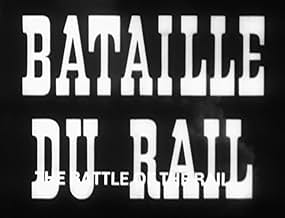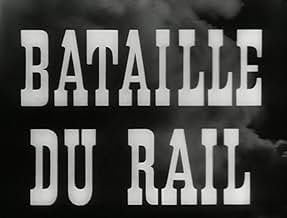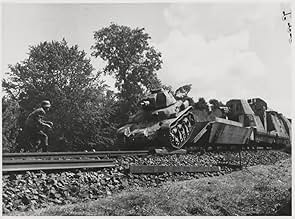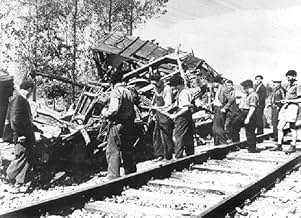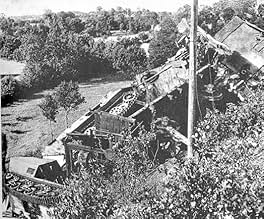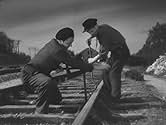CALIFICACIÓN DE IMDb
7.0/10
1.4 k
TU CALIFICACIÓN
Agrega una trama en tu idiomaRecounts the courageous efforts by French railroad workers who were part of an organized resistance during German World War II occupation.Recounts the courageous efforts by French railroad workers who were part of an organized resistance during German World War II occupation.Recounts the courageous efforts by French railroad workers who were part of an organized resistance during German World War II occupation.
- Dirección
- Guionistas
- Elenco
- Premios
- 3 premios ganados y 1 nominación en total
Marcel Barnault
- Cheminot
- (as Barnault)
Jean Clarieux
- Lampin
- (as Clarieux)
Jean Daurand
- Cheminot
- (as Daurand)
Lucien Desagneaux
- Athos
- (as Desagneaux)
François Joux
- Cheminot
- (as Joux)
Pierre Latour
- Cheminot
- (as Latour)
Robert Le Ray
- Chef de gare
- (as Leray)
Pierre Lozach
- Cheminot
- (as Lozach)
Pierre Mindaist
- Cheminot
- (as Mindaist)
Léon Pauléon
- Chef de gare St-André
- (as Pauleon)
Fernand Rauzéna
- Cheminot
- (as Rauzena)
Michel Salina
- Allemand
- (as Salina)
Charles Boyer
- Narrator
- (voz)
- (sin créditos)
- Dirección
- Guionistas
- Todo el elenco y el equipo
- Producción, taquilla y más en IMDbPro
Opiniones destacadas
For cinema enthusiasts, it is important to learn that the value of trains in the field of cinema has always been justly understood by filmmakers as truthful portrayals of trains have been extremely useful in making films which have become extremely popular with critics as well as with viewers. It would be appropriate to state that most of the films about war have an air of authenticity due to the realistic depiction of trains in them. It would not be an exaggeration to state that war films are popular due to the portrayal of trains in them. La Bataille Du Rail/The Battle of the Rails is the best example of a war film with trains and their impact on war as its major plot. The success of this film is due to the efforts of ordinary railway workers in war time France who were quick to realize that the damage to railway system in occupied France would be a key weapon in their fight against Nazi Germany. Those who favor technology in cinema would be shocked to learn how professionally the massive annihilation of trains was carried out in "The Battle of the Rails" despite the evident lack of technology. In 1946, this film by René Clément won a jury prize at Cannes Film Festival. In recent times, La Bataille Du Rail/The Battle of the Rails has been hailed as one of the classics of world cinema as it was shown in "Cannes Classics" section during 63rd Cannes International Film Festival held in 2010. Hardcore cinema enthusiasts would be thrilled to learn that it has been fully restored by INA in France where it can also be watched on DVD as well as Blu Ray formats.
This movie is not great. It's good, and it's only ok if you've already seen The Train 1964. This 1946 movie is artistic, stark, neo realist, blah blah, like many post war European made movies from the era. But it lacks character study and has only tactical measures and rebelliousness against not-so-evil Nazis as the reason for being, unlike The Train.
Army of Shadows 1969 is another example of a refined, not-so-purist remake of previous movies. It was just done better and had a longer lasting impact, like The Train.
But telling fans of La Bataille Du Rail that it's overrated just gets a lot of dislikes. Examine both movies yourself, but make sure you watch the 1946 movie FIRST so you won't be disappointed.
Army of Shadows 1969 is another example of a refined, not-so-purist remake of previous movies. It was just done better and had a longer lasting impact, like The Train.
But telling fans of La Bataille Du Rail that it's overrated just gets a lot of dislikes. Examine both movies yourself, but make sure you watch the 1946 movie FIRST so you won't be disappointed.
THE BATTLE OF THE RAILS is a rare little title that I managed to catch on Talking Pictures TV here in the UK in the first showing since 1960. It's a black and white drama about the efforts of the French Resistance to sabotage Nazi-controlled trains during WW2. The film is made with a documentary realism in which the action is narrated throughout. The photography is excellent and the pacing is fast. The film abandons typical conceits of characterisation and dialogue in favour of a focus on physical action, such as the sabotaging of tracks and trains and the subsequent derailments that follow. It's surprisingly tense, even thrilling at times.
Although there have been more nuanced, psychologically penetrating filmic depictions of French resistance under Nazi occupation, none has matched the sheer immediacy of René Clément's feature film debut. It represents a natural progression from his pre-war documentaries and indeed the early part is filmed in a documentary style with no clear delineation of character but changes tack dramatically when news comes through of the Allied landings and the Maquis plan greater acts of sabotage to prevent the Germans from moving armoured trains to Normandy.
Based upon real events and featuring many of the courageous participants in the Battle of the Rails of 1944, Clément uses cinéma vérité techniques and Russian-style montage to build momentum and suspense, culminating in the unforgettable derailment of the train convey which is shot from three different angles. Suffice to say the film's most powerful scene is the execution by firing squad of six randomly chosen railway workers. This is a superlative combination of image and sound as their deaths are accompanied by trains whistling in defiance. The post-sync dubbing of the mainly non-professional cast is pretty good and this viewer at any rate is intrigued as to who supplied the German voices. Clément has also been sure to use the strongest, most characterful faces for the close-ups.
It seems that the French suffered from collective amnesia following the liberation and Clément made a brave call for his film might have come too soon and been too close to home but its triumphalism ensured its great critical and commercial success whilst arguably paving the way for Alexander Esway's hugely popular 'Le Bataillon du Ciel' the following year. One cannot help but wonder whether John Frankenheimer was aware of this film when making 'The Train' twenty years on.
As well as being a moving testament to the kind of bravery of which very few are capable it marks, on a purely filmic level, the emergence of a special directorial talent that was to go from strength to strength.
Based upon real events and featuring many of the courageous participants in the Battle of the Rails of 1944, Clément uses cinéma vérité techniques and Russian-style montage to build momentum and suspense, culminating in the unforgettable derailment of the train convey which is shot from three different angles. Suffice to say the film's most powerful scene is the execution by firing squad of six randomly chosen railway workers. This is a superlative combination of image and sound as their deaths are accompanied by trains whistling in defiance. The post-sync dubbing of the mainly non-professional cast is pretty good and this viewer at any rate is intrigued as to who supplied the German voices. Clément has also been sure to use the strongest, most characterful faces for the close-ups.
It seems that the French suffered from collective amnesia following the liberation and Clément made a brave call for his film might have come too soon and been too close to home but its triumphalism ensured its great critical and commercial success whilst arguably paving the way for Alexander Esway's hugely popular 'Le Bataillon du Ciel' the following year. One cannot help but wonder whether John Frankenheimer was aware of this film when making 'The Train' twenty years on.
As well as being a moving testament to the kind of bravery of which very few are capable it marks, on a purely filmic level, the emergence of a special directorial talent that was to go from strength to strength.
Few films in the war genre so acutely bear the imprint of their historical moment as this one, released in 1946, on the immediate heels of the Second World War. Shot in a France still clearing rubble and reconciling its deep scars, the film operates not simply as cinema but as testimonial-lean, austere, and fiercely intentional in both style and spirit. The choice to blur the line between fiction and documentary, with many non-professional actors and real railway workers playing themselves, gives it a tactile authenticity that stands in stark contrast to the more theatrical or mythologizing approach of contemporary Allied productions. This hybrid aesthetic-docudrama before the term had even properly crystallized-grounds the film in a truth that was still palpably raw for its original audience, one that was not yet ready to sentimentalize the Resistance.
The cinematography is stark and functional rather than expressive, a reflection of both budgetary constraints and a deeper ideological commitment to realism. The camera lingers on machinery, process, and labor-not only to build suspense but to valorize the technical and human precision that went into acts of sabotage. There is a visual grammar of resistance, conveyed through tracking shots along rails, the choreography of hands on levers, and the rhythm of trains cutting through the French landscape. These sequences echo the industrial poetry found in Fires Were Started (1943), though here the stakes are higher and the violence more sudden. Unlike that British wartime docudrama, however, this film refrains from idealizing its protagonists; their courage is neither clean nor abstract-it emerges through action, in the face of brutality, and often ends without glory.
Sound design plays a remarkably understated but powerful role. The mechanical clatter of trains, the hiss of steam, and the ambient hum of resistance are given equal weight to dialogue. Silence is often used with brutal efficiency, especially in the moments leading up to acts of sabotage or during reprisals. The absence of a swelling score or overt musical cues deprives the viewer of catharsis, insisting instead on a more sober engagement with events.
Performance is deliberately muted, almost anti-theatrical. This is not a vehicle for star power but for collective identity. The ensemble approach-coupled with the use of railway workers and resistance fighters portraying versions of themselves-dismantles the usual hierarchy between actor and role. At times, this can lead to a certain stiffness in delivery, but it serves the film's ideological mission: to honor the anonymous and the ordinary, the faceless who shaped history. There is little psychological probing; instead, character is revealed through tasks performed, risks taken, and loyalties tested under pressure. This approach diverges sharply from the character-driven drama of The Train (1964), which, though also concerned with sabotage on the rails, places far greater emphasis on individual cunning and dramatic arc than on the collective ethic foregrounded here.
Shot and produced during France's immediate post-liberation period, the film cannot be extricated from the cultural and political climate of 1945-46. It functions as both a rallying cry and an act of purification-reaffirming a narrative of widespread resistance at a time when national memory was being rapidly reassembled. France had endured a catastrophic and humiliating military defeat in 1940, with the collapse of its army in just six weeks and the swift occupation of its territory. That trauma lingered heavily, not only as a strategic failure but as a perceived existential collapse of the French military establishment. In this context, the film takes on the added function of counterbalance: by highlighting the technical sophistication, precision, and coordination of railway sabotage, it implicitly restores a kind of military competence and honor to the national narrative. The resistance shown here is not portrayed as a spontaneous or amateurish reaction, but rather as a clandestine force with the rigor, discipline, and tactical efficacy that the French army had failed to project during the actual conflict. The trains are both symbol and weapon, and mastering them becomes an act of reclaiming agency. In depicting this underground war with such methodical clarity, the film offers a compensatory image-France not as a passive victim of Blitzkrieg, but as a nation that fought back with calculated resolve and strategic skill, albeit from within.
This is not subtle, nor is it meant to be. The message is delivered with clarity and urgency: the resistance was broad, the people were brave, and France stood against occupation. Yet even as it partakes in myth-making, it does so with a notable sense of gravity and restraint. There is no bombast, no overt patriotic swelling-only the sober gaze of a nation trying to reclaim its dignity through a kind of neorealist liturgy.
The editing follows a rhythm that is closer to reportage than traditional war cinema. Cuts are often abrupt, even jarring, emphasizing the fragmentary and volatile nature of resistance life. This unpolished style, which might be read today as primitive, was at the time a radical break from the smoother, studio-bound productions of prewar cinema. It reflects both a shortage of resources and a defiant embrace of the provisional and the handmade. The decision to maintain a chronological narrative structure, eschewing flashbacks or narrative tricks, serves to mirror the straightforward heroism the film wishes to commemorate.
If it falters, it is perhaps in the moments where the didactic impulse overpowers the dramatic. Certain sequences lean heavily on archetype and moral clarity, flattening complexity in favor of edification. Yet even here, one senses that the urgency of historical rehabilitation-of reclaiming a narrative of resistance amid lingering collaborationist shame-justifies the lack of ambiguity. In this sense, the film is both an artwork and a social instrument, forging consensus as much as crafting cinema.
The film endures less for any technical innovation than for its clarity of purpose and its profound integration of content and form. It does not aim to entertain or even to move in the conventional sense-it demands recognition. And in doing so, it carves out a place not only in the canon of war cinema but in the deeper, more solemn archive of historical memory.
The cinematography is stark and functional rather than expressive, a reflection of both budgetary constraints and a deeper ideological commitment to realism. The camera lingers on machinery, process, and labor-not only to build suspense but to valorize the technical and human precision that went into acts of sabotage. There is a visual grammar of resistance, conveyed through tracking shots along rails, the choreography of hands on levers, and the rhythm of trains cutting through the French landscape. These sequences echo the industrial poetry found in Fires Were Started (1943), though here the stakes are higher and the violence more sudden. Unlike that British wartime docudrama, however, this film refrains from idealizing its protagonists; their courage is neither clean nor abstract-it emerges through action, in the face of brutality, and often ends without glory.
Sound design plays a remarkably understated but powerful role. The mechanical clatter of trains, the hiss of steam, and the ambient hum of resistance are given equal weight to dialogue. Silence is often used with brutal efficiency, especially in the moments leading up to acts of sabotage or during reprisals. The absence of a swelling score or overt musical cues deprives the viewer of catharsis, insisting instead on a more sober engagement with events.
Performance is deliberately muted, almost anti-theatrical. This is not a vehicle for star power but for collective identity. The ensemble approach-coupled with the use of railway workers and resistance fighters portraying versions of themselves-dismantles the usual hierarchy between actor and role. At times, this can lead to a certain stiffness in delivery, but it serves the film's ideological mission: to honor the anonymous and the ordinary, the faceless who shaped history. There is little psychological probing; instead, character is revealed through tasks performed, risks taken, and loyalties tested under pressure. This approach diverges sharply from the character-driven drama of The Train (1964), which, though also concerned with sabotage on the rails, places far greater emphasis on individual cunning and dramatic arc than on the collective ethic foregrounded here.
Shot and produced during France's immediate post-liberation period, the film cannot be extricated from the cultural and political climate of 1945-46. It functions as both a rallying cry and an act of purification-reaffirming a narrative of widespread resistance at a time when national memory was being rapidly reassembled. France had endured a catastrophic and humiliating military defeat in 1940, with the collapse of its army in just six weeks and the swift occupation of its territory. That trauma lingered heavily, not only as a strategic failure but as a perceived existential collapse of the French military establishment. In this context, the film takes on the added function of counterbalance: by highlighting the technical sophistication, precision, and coordination of railway sabotage, it implicitly restores a kind of military competence and honor to the national narrative. The resistance shown here is not portrayed as a spontaneous or amateurish reaction, but rather as a clandestine force with the rigor, discipline, and tactical efficacy that the French army had failed to project during the actual conflict. The trains are both symbol and weapon, and mastering them becomes an act of reclaiming agency. In depicting this underground war with such methodical clarity, the film offers a compensatory image-France not as a passive victim of Blitzkrieg, but as a nation that fought back with calculated resolve and strategic skill, albeit from within.
This is not subtle, nor is it meant to be. The message is delivered with clarity and urgency: the resistance was broad, the people were brave, and France stood against occupation. Yet even as it partakes in myth-making, it does so with a notable sense of gravity and restraint. There is no bombast, no overt patriotic swelling-only the sober gaze of a nation trying to reclaim its dignity through a kind of neorealist liturgy.
The editing follows a rhythm that is closer to reportage than traditional war cinema. Cuts are often abrupt, even jarring, emphasizing the fragmentary and volatile nature of resistance life. This unpolished style, which might be read today as primitive, was at the time a radical break from the smoother, studio-bound productions of prewar cinema. It reflects both a shortage of resources and a defiant embrace of the provisional and the handmade. The decision to maintain a chronological narrative structure, eschewing flashbacks or narrative tricks, serves to mirror the straightforward heroism the film wishes to commemorate.
If it falters, it is perhaps in the moments where the didactic impulse overpowers the dramatic. Certain sequences lean heavily on archetype and moral clarity, flattening complexity in favor of edification. Yet even here, one senses that the urgency of historical rehabilitation-of reclaiming a narrative of resistance amid lingering collaborationist shame-justifies the lack of ambiguity. In this sense, the film is both an artwork and a social instrument, forging consensus as much as crafting cinema.
The film endures less for any technical innovation than for its clarity of purpose and its profound integration of content and form. It does not aim to entertain or even to move in the conventional sense-it demands recognition. And in doing so, it carves out a place not only in the canon of war cinema but in the deeper, more solemn archive of historical memory.
¿Sabías que…?
- TriviaIn part financed by what had been the Resistance as a way of showing international audiences what the French population had been facing under Nazi oppression. The Resistance was also keen to let the world know that they had been actively involved in disrupting the German war machine in France as the international perception at the time was that the French had capitulated and collaborated a little too easily with their Nazi captors.
- ErroresRailway worker tapping Morse code just repeats letter "V" most of the time with only a few exceptions.
- Créditos curiosos(in cast) et Les cheminots de France
- ConexionesFeatured in Cannes... les 400 coups (1997)
Selecciones populares
Inicia sesión para calificar y agrega a la lista de videos para obtener recomendaciones personalizadas
- How long is The Battle of the Rails?Con tecnología de Alexa
Detalles
- Fecha de lanzamiento
- País de origen
- Sitios oficiales
- Idiomas
- También se conoce como
- The Battle of the Rails
- Locaciones de filmación
- Gare SNCF, Saint-Brieuc, Côtes-d'Armor, Francia(first scenes, train station)
- Productoras
- Ver más créditos de la compañía en IMDbPro
- Tiempo de ejecución1 hora 25 minutos
- Color
- Mezcla de sonido
- Relación de aspecto
- 1.37 : 1
Contribuir a esta página
Sugiere una edición o agrega el contenido que falta

